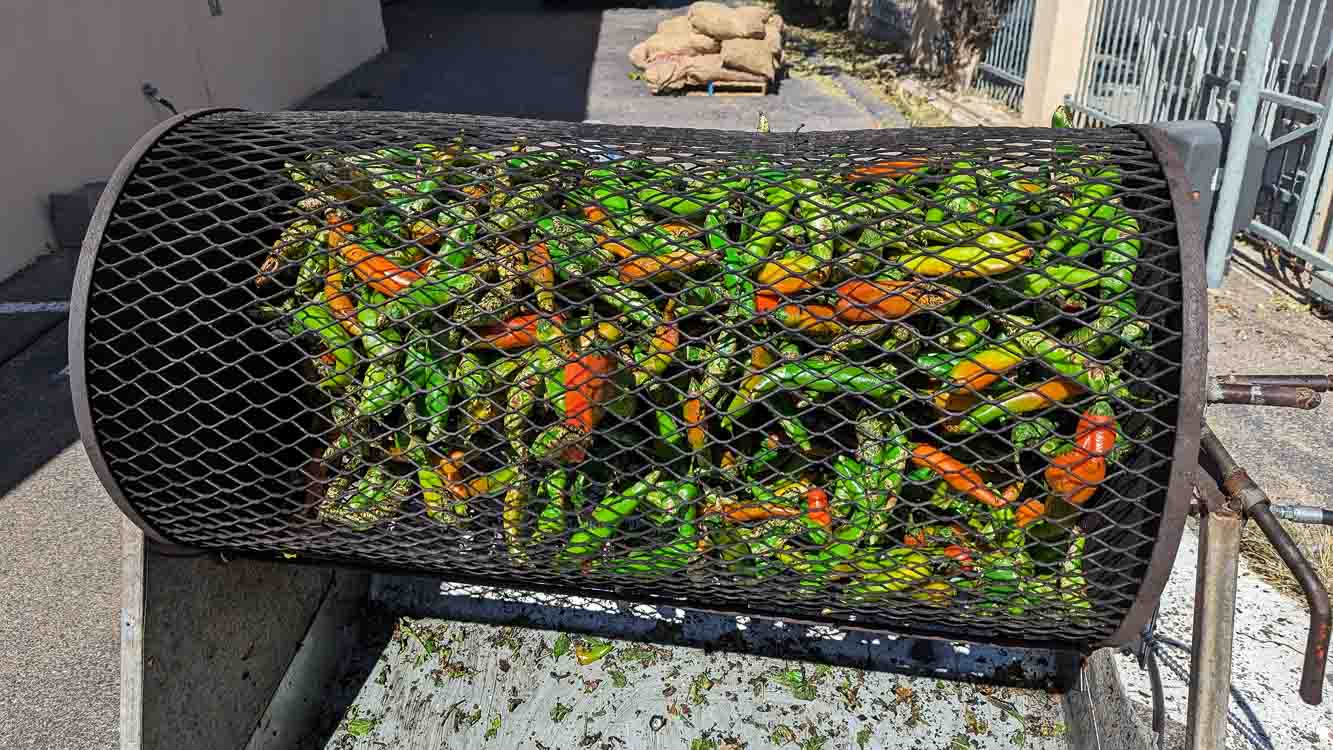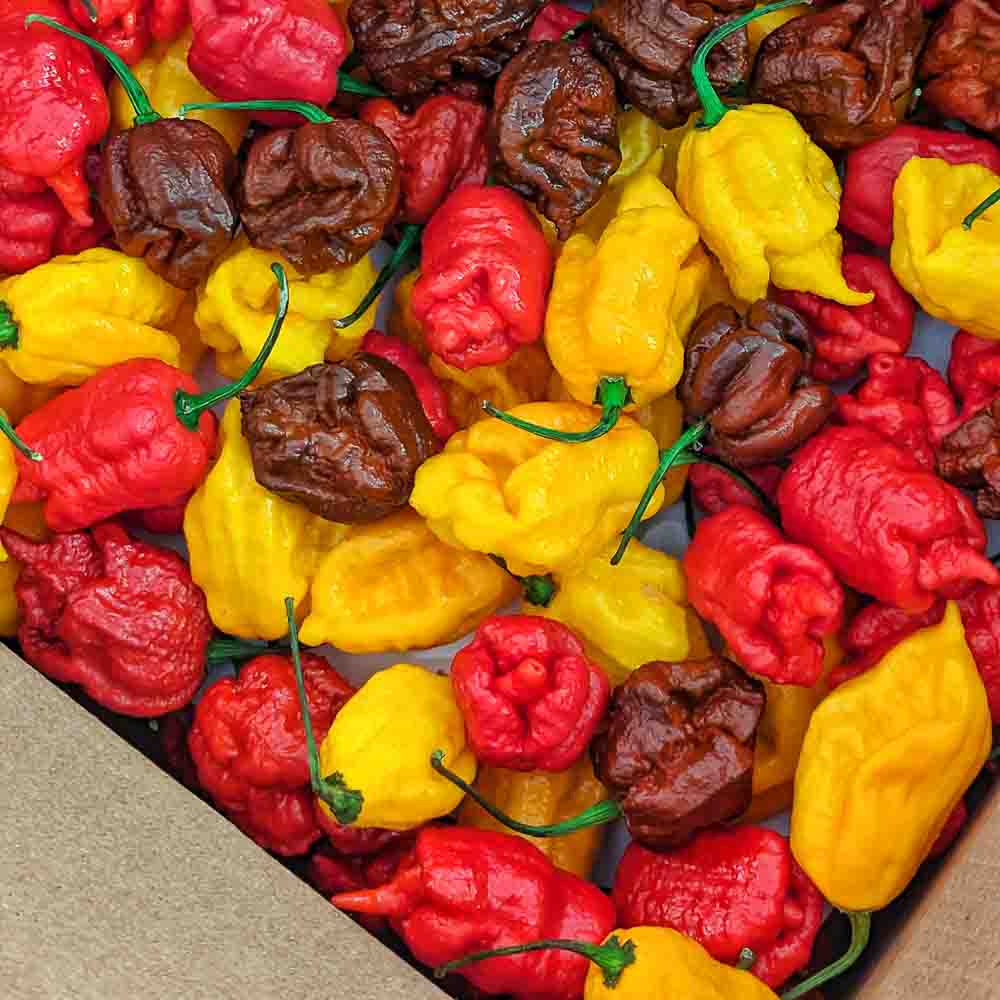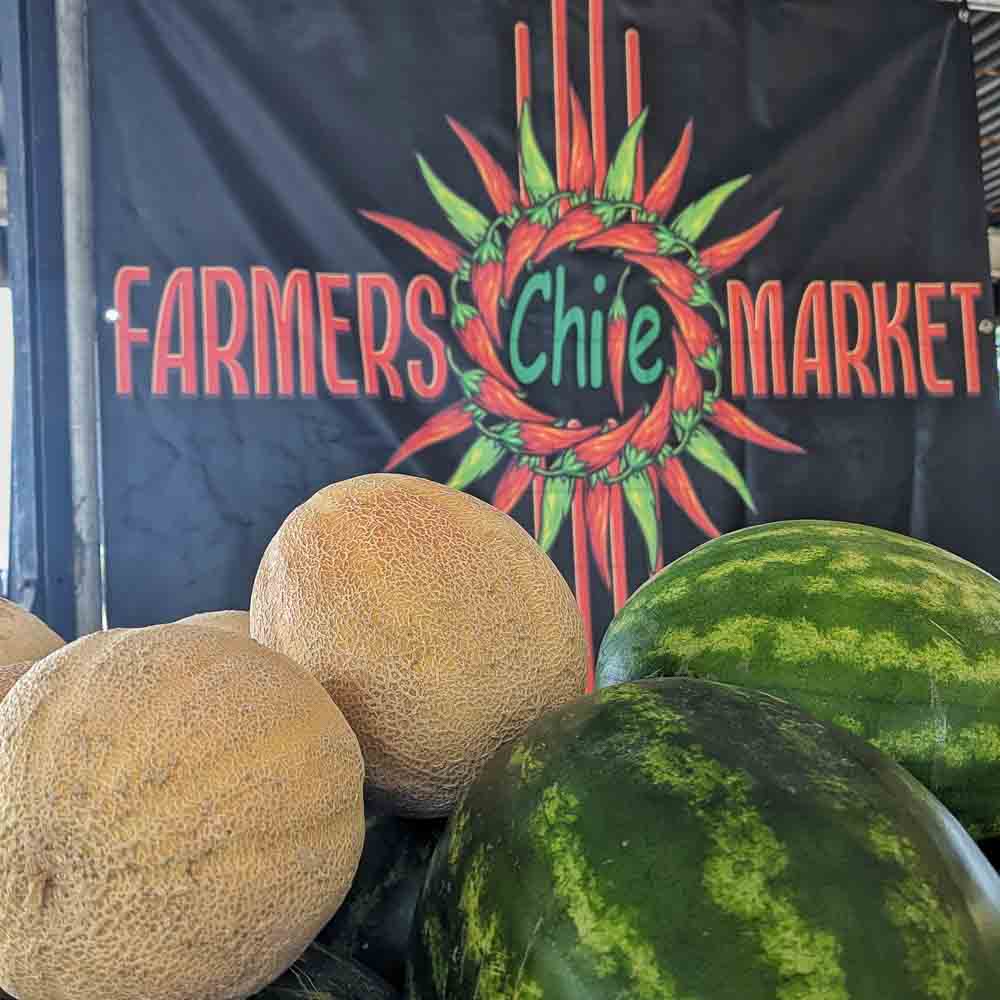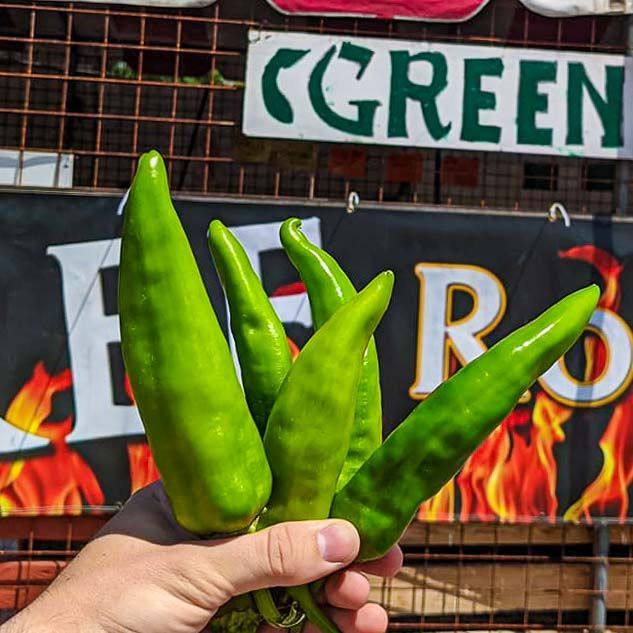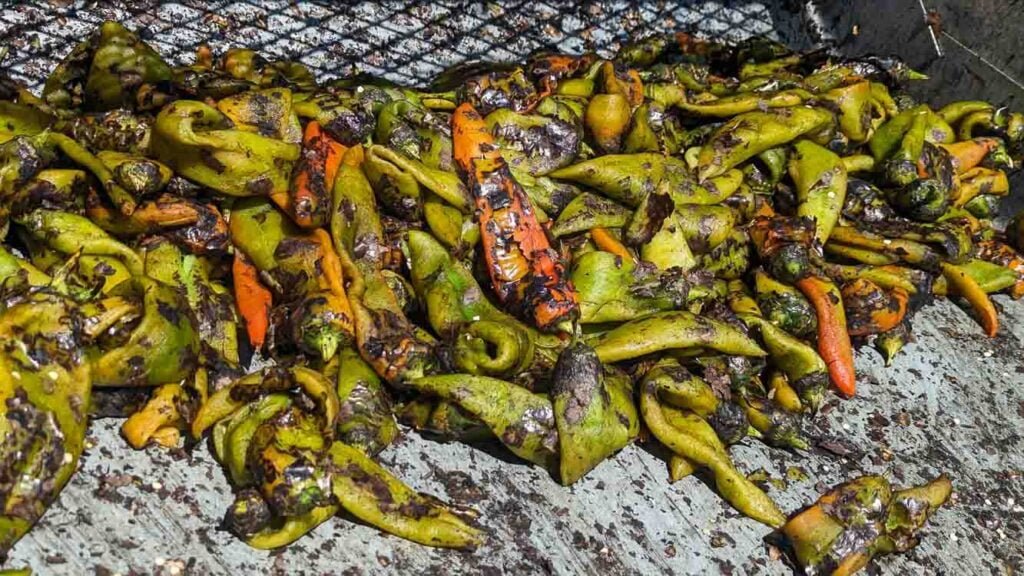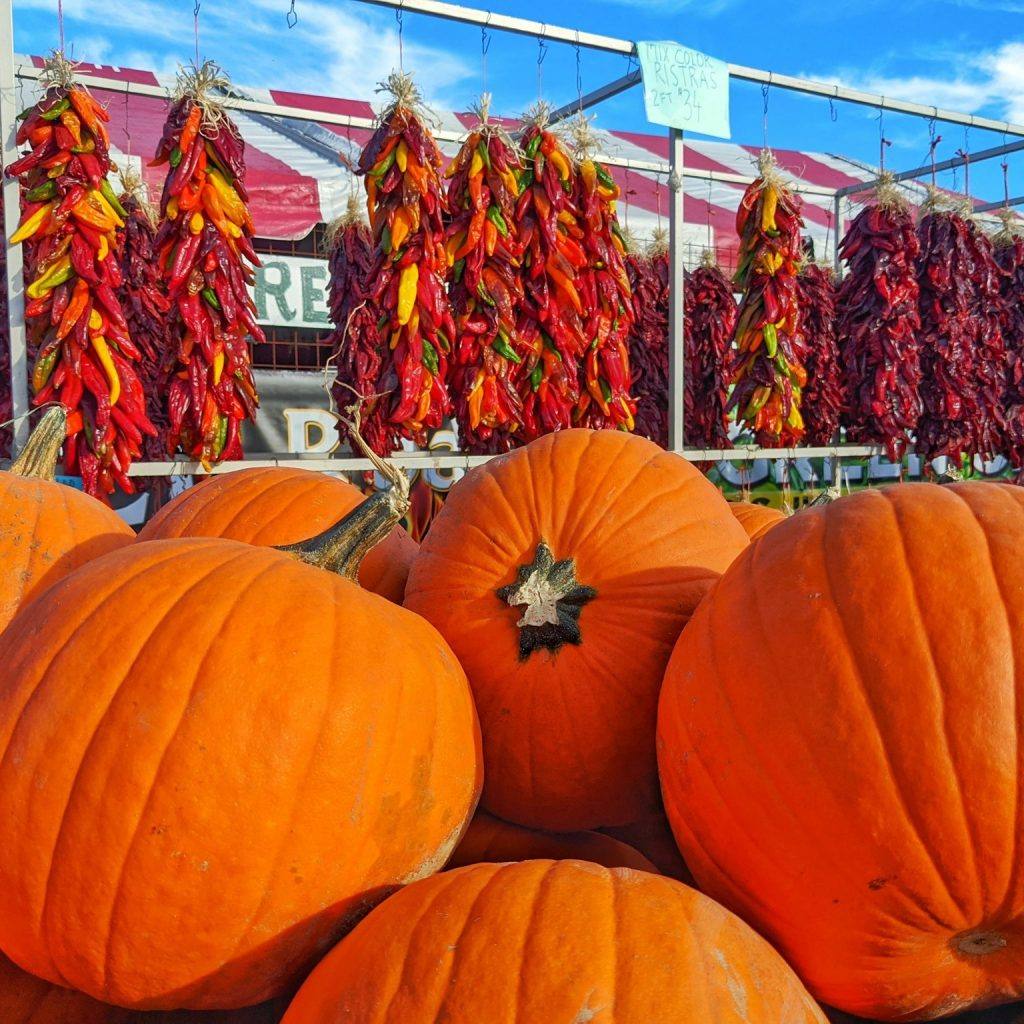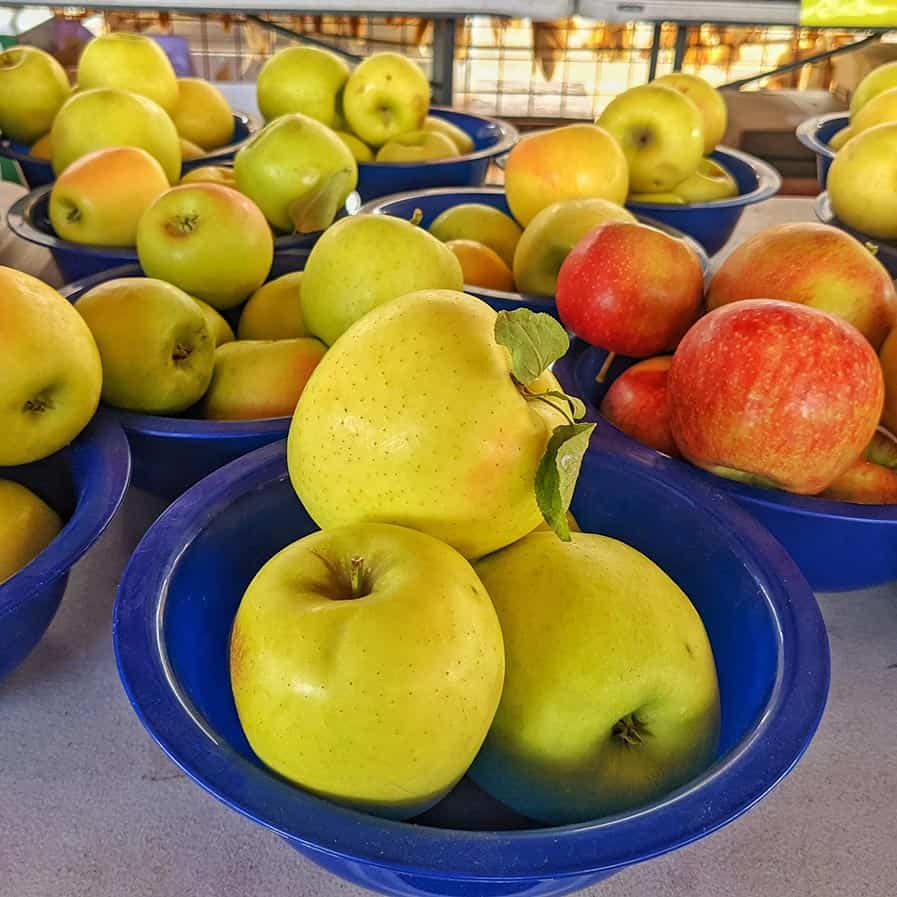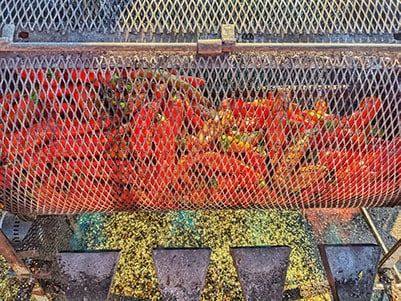Your cart is currently empty!
Tag: fresh
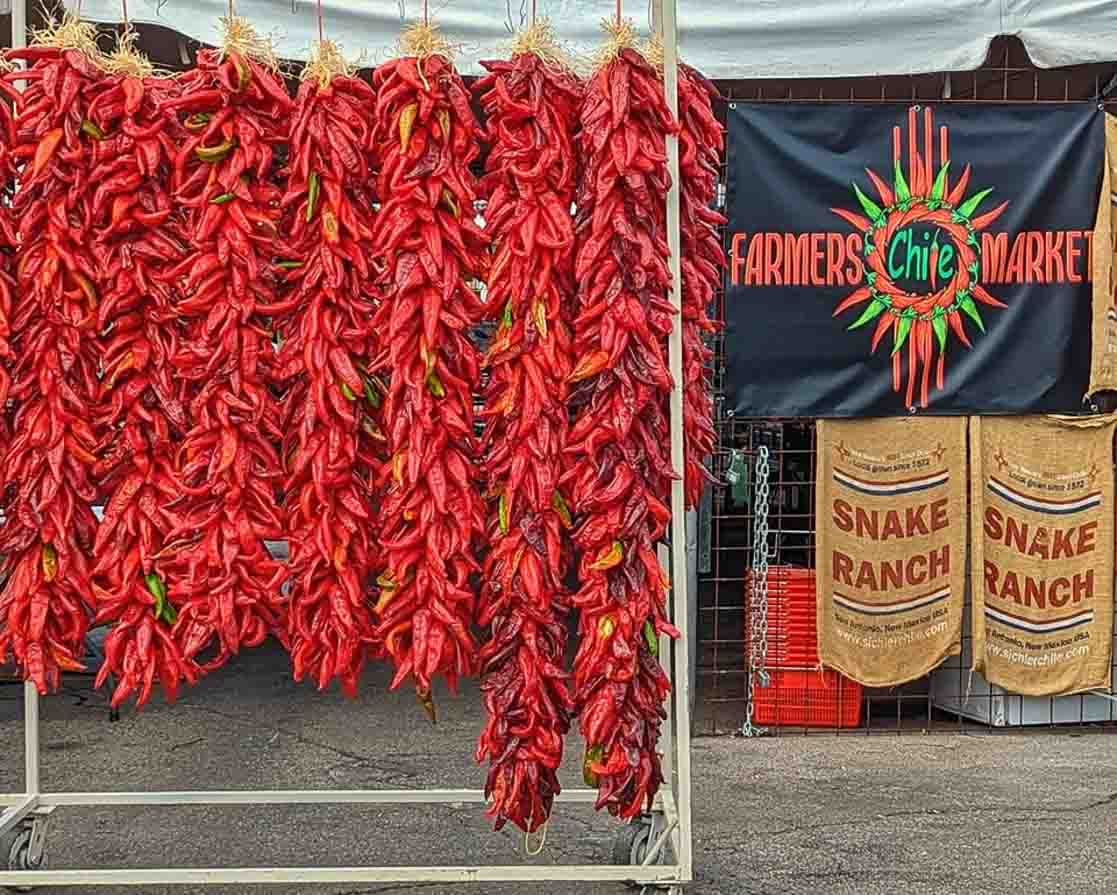
What we Sell at Farmers Chile Market
At Farmers Chile Market, we have a wide variety of different New Mexican products, but much of it is different at different times. There are deeper explanations of this in our post about the chile season. We are open from the first Friday of August every year until Christmas. In 2024, we will be open from Friday August 2nd! In early August, we typically have the least amount of products available, as it is quite early in the chile season. We typically have a few varieties of fresh green chile available for roasting, and also have those varieties already roasted in the freezer for people who want a smaller amount. We also often have a decent amount of dried red chile pods for sale at this time too. Other than that, we usually have chile pasado from the last year to cover the different chile flavors that people are looking for.
Dried chile
Some of our most important products are dried chile, whether they are Hatch red chile pods, Mexican chile, chile pasado, red chie powder, green chile powder, dried superhots, dried aji charapita, or something else. The main reason why is that by drying chili peppers, they can keep a good flavor for a couple years, even without refrigeration. Sun dried red chile pods are especially important in New Mexico, as they are a core component in a red chile sauce. Although a ristra you get from us will be edible, it is a better value to buy a full sack of dried chile pods, as the amount of chile is much more. Ristras are beautiful, but they take a lot of time to make, so the price is higher.
New Mexico Red Chile Pods
We normally carry New Mexico red chile pods in medium, hot, and extra hot varieties, and also try to carry the XXX-hot Lumbre chile variety when we can get it. Usually we don’t run out of these varieties of red chile pods, but occasionally shortages happen, like what happened in 2023, when most of the state of New Mexico ran out. In case we sell out of a specific variety of red chile pods, we typically have at least two trucks per week from Hatch that we can get more from. If the chile season is normal, the new crop of Hatch red chile pods comes out around late October or early November.
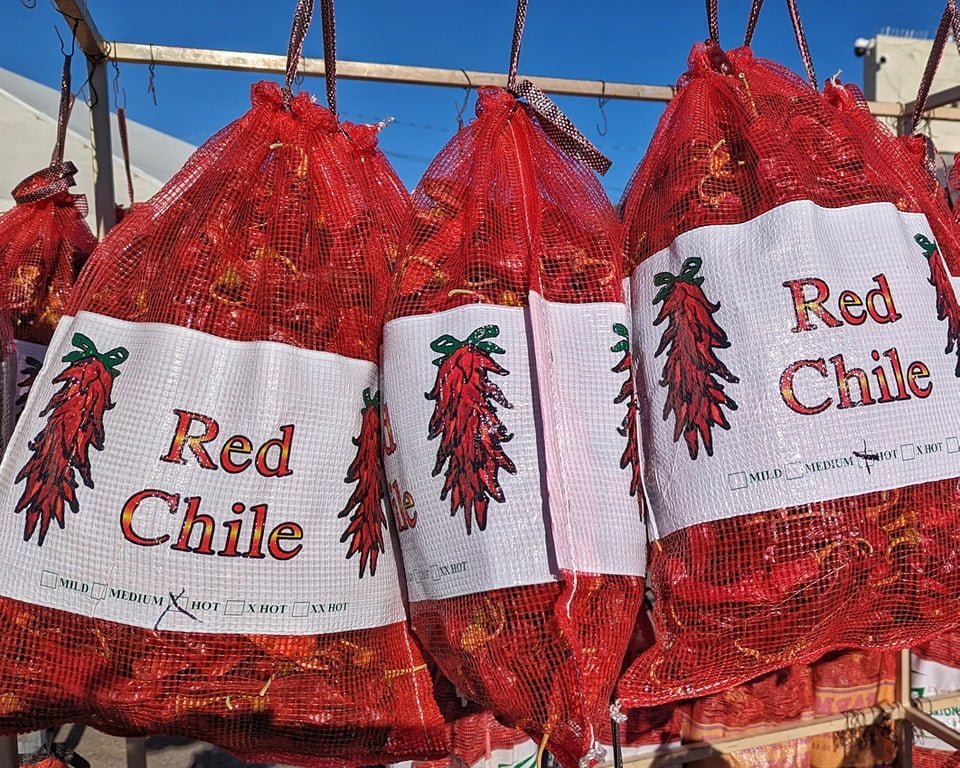
These sacks of red chile pods are enough for a ton of red chile sauce! Chile Ristras
These dried strings of red chile make great southwestern accent pieces for an entryway, a doorway, a kitchen, or patio! More than just that, all the ristras we sell are edible red chile! We don’t treat ristras in order to keep them as a double use item! The red chile pods that ristras are made with are quite delicious, and whip up into a great red chile sauce!
New Mexico Red Chile Powder
We carry many different varieties of red chile powder, including mild, medium, hot, extra hot, and XXX-hot varieties. In addition to this, we also try to carry ghost pepper powder, as some people are really looking for the hottest stuff they can get. Our New Mexico chile powder is made from sun dried red chile pods grown and processed right in the sunny Hatch valley of southern New Mexico. Red chile powder has a ton of different ways to cook with it, such as using it as a simple spice or making a whole chile sauce with it! We have a page dedicated just to that, so you can get more ideas about how to use red chile powder!
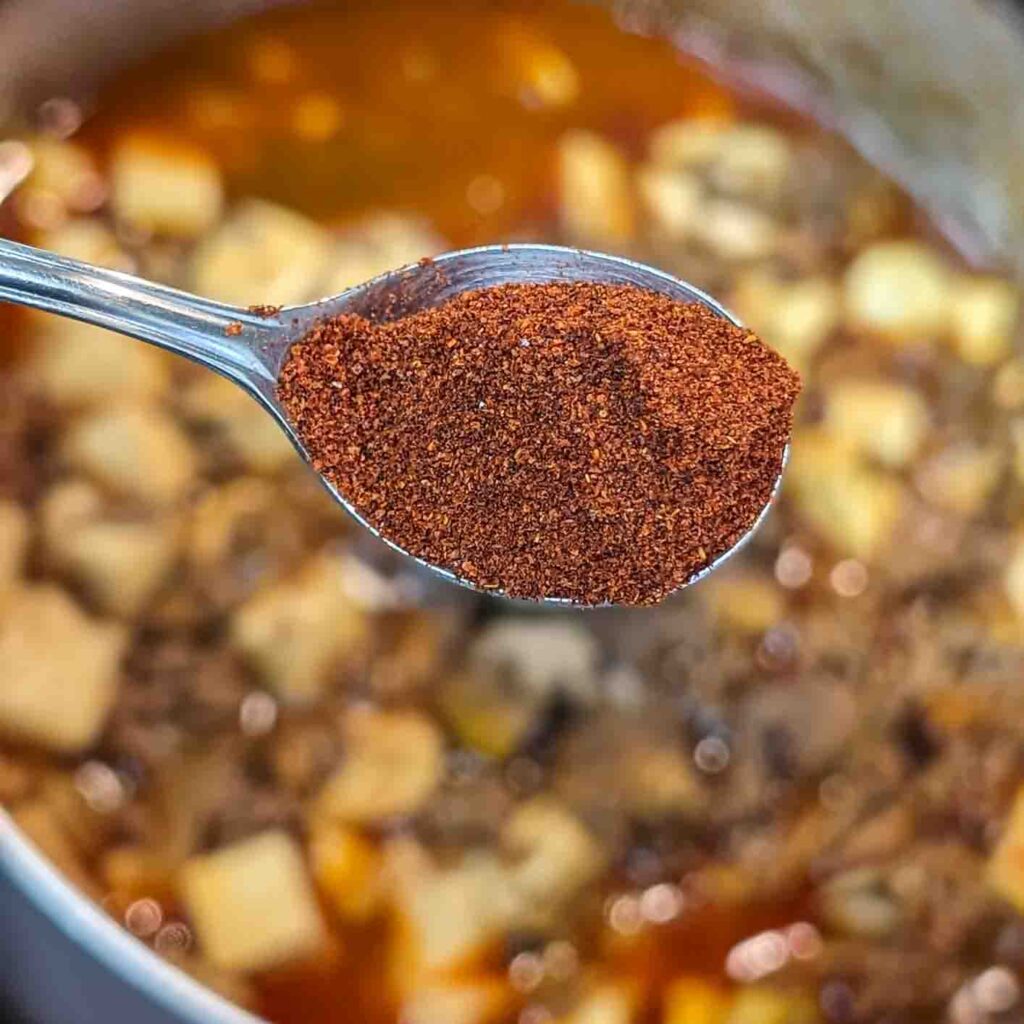
This spoonful of red chile powder took this Mapo Tofu dish up a notch! Hatch Green Chile Powder
We also carry New Mexico green chile powder, ranging from mild to extra-hot as well. Green chile powder is typically machine dried, as the color of sun dried green chile isn’t really appealing. Because of the machine drying process, it tends to be a little sweeter than sun dried red chile, as the sugars in the chile haven’t had the time to ferment. That being said, it still makes a great flavor base, and can add a nice chile flavor to whatever dish you want!
Chile Pasado
We roast green chile every day during the chile season! This chile needs to be preserved, and although the most common modern way is freezing, chile pasado is in some ways the best way to preserve roasted green chile. Chile pasado is roasted, peeled, and dried green chile. As the shelf life of chile pasado is years instead of days like fresh green chile, we typically have chile pasado flavors available sooner than fresh green chile. This goes especially for the chile varieties which take longer to mature enough for roasting, like extra hot and Lumbre varieties. In case you are buying chile in the very early season and can’t wait for the really spicy stuff to come out, consider getting some chile pasado to hold you over! The flavor is amazing, and it doesn’t need to be frozen!
Mexican chile
We try to carry a decent amount of dried Mexican chile as well in order to have a wide variety of chile products! The varieties we usually stock are guajillo, ancho, chile de arbol, chipotle morita, and more. Mexico has a very wide range of different types of chili peppers available, and we try to get whatever we can. I take at least two trips to El Paso every year to pick up dried chile products from Mexico. We are at our core, a chile market. I want to sell more types of chili peppers than anyone in Albuquerque!
Superhot and Exotic chili Peppers
Although we also stock plenty of fresh superhots and exotic chili peppers, we also have a large selection of dried chili pods as well! The season for these kinds of chili peppers are shorter than the Hatch chile season, so we try to stock up a lot to dry when they are available! We typically dry a lot of Carolina Reapers, Ghost Peppers, and Aji Charapita primarily. In addition to dried pods, we try to carry at least one variety of superhot chili powder like ghost pepper powder. The superhot chili peppers are fantastic for making fiery sauces, as just one pod will turn a whole pot into something that will make you breathe fire! Aji charapita on the other hand is not terribly spicy, with a heat level not too different from chile pequin. It has a nice fruity flavor profile, and makes a really nice brightening addition to many things. Personally, I love using aji charapita in a chimichurri sauce!
Fresh Chile
Green Chile
In terms of fresh chile, we try to carry five different New Mexico green chile varieties whenever they are available. These are Mild, Medium, Hot, Extra-Hot, and XXX-Hot. We start every chile season with exclusively Hatch green chile from the Hatch Valley in southern New Mexico, but also sell chile from other popular growing regions of New Mexico as the season progresses. Regardless of where our chile comes from in New Mexico, you can be sure that we do our due diligence to find the best chile at the best price every year. In the early season, usually less varieties are available, and the late season is the same. If you come in September, we almost always have all heat levels of green chile available daily.

We roast green chile every day of the chile season! Red Chile
Around the start of September, we also carry fresh red chile out of Hatch, New Mexico. Whether you would like us to roast it for you, or if you are planning to tie a chile ristra, we should have fresh Hatch red chile available, but it frequently sells out quickly! We get fresh chile shipments 4 times a week throughout the season, so if we run out, more will be coming soon!
Superhot and Exotic chili Peppers
During the season, we also carry superhot peppers like Carolina reapers and ghost peppers in our refrigerators ready to slice up and mix with some other ingredients to make some fiery sauces! Fresh exotic peppers like Aji varieties are quite fruity, and taste better fresh than dried in my opinion. With superhots, the spice is so potent, that fresh or dried both feel quite similar. The flavor is less pronounced than other chili peppers, but the spice comes through in force!

these fresh superhots pack a punch! Other Local Produce
Although we get a small amount of products from out of state like Colorado peaches, over 95% of what we sell is locally grown in New Mexico. We get new crop pinto beans and pumpkins from Ness Farms in Estancia, watermelons and onions from several farms down in the Hatch valley, cantaloupes, honeydews, and tomatoes from San Antonio, NM in the Socorro Valley, apples from Velarde, NM, chicos from Espanola, and more. Like my dad did decades ago, I drive all around looking for different local farms to get high quality produce from New Mexican farms.

Keeping it local keeps our New Mexican community strong! What we sell online
Below is a list of all the different products we sell online. Because of various reasons, we sell less products online than in our store, but we try to have a wide variety of chile products and New Mexican goodness online too!

How to choose good New Mexico chile
It’s June now, which means that chile has already been in the ground for over a month in all the major farming regions of New Mexico. We are around 2 months away from the 2024 chile season, and the time is right for a guide to how to pick out good chile.
First things first is to evaluate the retailer you are buying from. If they are a typical grocery store and their chile is cheap, it is probably a chile variety with less flavor than many varieties we and other local New Mexican chile roasters sell. Second, make sure they let you at least try the raw chile to know the flavor. Don’t expect to try Hatch chile already roasted, as it leads to food safety concerns. Spice and other flavors associated with different varieties is impossible to explain. In order to get the right product, you should be allowed to sample the product. If they don’t let you, consider a different place. At Farmers Chile Market, we always let customers try raw chile to get an idea of what the flavor of each chile variety we sell.
How to try raw chile
Tasting chile is very important if you want to get the ideal match of heat and flavor. As chile is a seasonal product, it means every season has different characteristics. Just like wine, tea, coffee and other agricultural products, chile’s flavor also varies based on the weather and other factors. More than just that, there are many different chile varieties to choose from.
Break the chile away from you or anyone else so the juices don’t fly in anyone’s face. No one wants a face full of extra hot chile juice! Try to break it around the middle, as this is where the heat from the chile is most indicative of the spice level of the chile. Raw chile has the majority of its spice centralized in the membranes near the seeds. This means the tip often has very little heat, while near the stem might be like fire. During roasting, the membranes break open, and the juices flow all around during the steaming process, which makes the spice level more uniform throughout the chile. Bite one side, and share the other side with a friend, or throw it in the roaster with your sack of chile if you like it. At Farmers Chile Market, we will gladly explain the differences in flavor and let you try whatever flavor you want. We even have free water, in case you try something a little too spicy. This is one of many little things we do to try to be the best place to get chile roasting in 2024!

Super spicy New Mexican Lumbre chiles. Be especially careful breaking these! How to see if fresh green chile is good
The easiest things to notice are wrinkling and decay. If a lot of the chile looks decayed, go to a different store, as wherever you are obviously doesn’t care enough to remove bad product. We put fresh chile out multiple times a day and always remove decay when we see it, as it can ruin nearby chile as well. Another thing to look for is wrinkling. While a little wrinkling is not too bad, excessive wrinkling can make a chile incredibly hard to roast and peel. In our raw chile section, we rotate out the chile several times, and roast it before it wrinkles too much. Not only that, but we get shipments 3 times a week, so our chile we sell is at most only 3-4 days since harvest. Good chile roasters pay very close attention to these details, and you can be assured to get a quality product. To summarize, a little wrinkling is ok, but don’t trust a place that puts out a lot of decayed chile. Ideal chile is plump and firm, with a flavor that suits you and the people you eat with. Don’t be afraid to try, as you know and understand what flavor is best for you much more than just trusting a sign that says mild, medium, hot, or extra hot.
What to do after buying Green Chile

Many different varieties of fresh New Mexico chile. Notice that there aren’t many wrinkles. Your chile needs to be roasted of course! If the place you buy from has a roaster, ask them to roast it for you. It will save a lot of time! That being said, many bigger grocery stores don’t do a great job at training their chile roasters. I have a guide to roasting chile written for both roasting as a profession chile roaster, and also for roasting at home. If the roasting area doesn’t look professional, odds are it isn’t. I hear complaints regularly from people who go to less professional chile roasting operations every year and are dissatisfied. It is sometimes better to just roast chile at home than get an inexperienced person to roast it for you.

Roasted chile should look like this when finished. Most of the peel is already gone, but it isn’t charred How to choose a good Hatch red chile ristra
To start things off, I should say that decorative things are very subjective, as everyone has different artistic tastes. That being said, there are some things I will recommend looking out for. First, make sure that the ristra is straight. If you see any obvious bends, it probably means the ristra was not properly stored, and will have a weak point, from which chile will easily break off. Second, look at how plump it is. Some ristra makers skimp out on chile, and while the length is correct, it shrinks down a lot once it is dried. A ristra should be quite full, with around 3 chiles per layer. Some ristras have a shape that curves outward a lot, and some have shapes that curl inward. What specific look you like is really up to you. As they say, “beauty is in the eyes of the beholder.” Look for breakage of chile if the ristra is not fresh. Generally you don’t see much decay on ristras. As they age, some ristras will have brown patches on some chile, this is just the color that green chile turns to when it dries. It just means that the chile originally was not completely red when it was tied to the ristra. It will still taste good, even if it isn’t the most pretty chile.
If you have more questions about ristras, our Ristra FAQ has plenty of answers for you.

October is a beautiful time here The New Mexican Chile Experience
If you are from New Mexico, you understand about what it is like to get chile roasted here. For people who are outside of New Mexico and have to rely on grocers in your area, I highly recommend making the chile season part of your reason to visit New Mexico. In October, we have the Balloon Fiesta, the worlds largest hot air balloon festival. It always occurs toward the end of chile season, but we will almost always still be roasting when it occurs, barring freak cold snaps, which do occasionally end the chile season early. One of the coolest things to do in New Mexico is visiting a chile roaster, as you can see the lifeblood of New Mexican food up close. If you come to our chile stand at 2010 Eubank Blvd NE in the northeast heights in Albuquerque, we will do our best to show you a delicious side of New Mexican culture. In case you are planning a trip to New Mexico specifically for chile, I highly recommend checking out the Hatch Chile Festival too!

The Many Varieties of Chile
Many types of New Mexico chile
Although we sell green chile by temperature, Mild, Medium, Hot, Extra Hot, XXX-hot, etc, the differences between New Mexico chile varieties run deeper than that.
Chile has been a big thing in New Mexico for a long time, and as a result, many different varieties exist. Many are bred for their size and meatiness, such as Big Jim. Some are bred to bring the heat, like Lumbre. Some chile is bred to mass produce, like Arizona 88. We don’t sell that one, as it is an inferior product, but most giant grocery stores do. Everyone has something different they look for in New Mexico chile, and that is why we let people see and try the chile before they buy. It is important for us to make sure you have the best possible chile experience.
The purpose of Different chile
Every chile serves a purpose, which includes much more than simply heat level. For our hot green chile, we generally get Miss Junie. Our ristras are made with Sandia, a chile variety developed by Roy Harper in 1956. Both are a solid “hot” temperature, but the Miss Junie a is slightly spicier, more meaty variety, which means it will roast better. Sandia is less so, which leads to better drying.
There are many different things that consumers look for in chile. Sometimes they need chile that is long and straight, so they can make chile rellenos. Big Jim, a cultivar developed by Roy Nakayama in the 1970s is typically the best for this. The mild 1904 and 6-4 varieties also work, as well as the hot Miss Junie.
Sometimes, people want as hot as possible. Traditionally, Barker was the choice for spice-lords, but Lumbre has overtaken its throne in recent years. Barker remains as the primary extra hot variety at Farmers Chile Market and most other chile stores. Lumbre is our XXX-hot variety.
The original New Mexico chile pepper was Numex No. 9, developed and released by Fabian Garcia a little over 100 years ago. Although it is not as common as other famous varieties of New Mexico chile in modern times, its purpose as the forefather of Hatch chile will always be significant.
Differences in the same varieties
Red or Green?
Red chile and green chile is another factor which is important. Green chiles have many differences with red. Red fruits are more mature, with a lot more sugar. They take longer to roast, and the peel is more resilient. They also dry much better, and hold their shape well, where green typically shrivels and doesn’t look great.
Red Chile
New Mexico chile typically ripens up to become red chile. Fresh red chile is quite sweet, but most people don’t eat it when it is fresh. Instead, most red chile is sun dried. These sun dried red chile pods are then ground into red chile powder by processors in Hatch New Mexico, or sold to consumers as whole chile pods. These pods are the base of New Mexico’s mother sauce, the red chile sauce. The arrival of fresh red chile is also a big milestone in the chile season, as it means that chile ristras are available. Although ristras are often used as just a decoration, they are also edible if they are untreated, and many fantastic chile sauces are made with chile ristras!
Green Chile
The arrival of green chile marks the beginning of what people refer to as the chile season, which typically goes from the start of August to nearly the end of October. Green chile is almost exclusively roasted and peeled before eating, but green chile powder has also become more and more popular in recent years. After roasting, it is typically bagged up in freezer bags and frozen for consumption at a later date. Chile Pasado is another way to preserve roasted green chile by drying it. Green chile is much less sweet than red chile, and I would argue that its flavor is somewhat more grassy and herbal than red. Due to it needing to be roasted to peel it off, I recommend finding a good chile roaster, or reading our guide to roasting green chile!
Common New Mexico Chile Varieties
Mild Chile Types
There are many chile varieties such as R Naky which are primarily grown as paprika type chile, and not meant to be roasted. As we are a chile roaster, we will primarily focus on chile commonly used in roasting or making New Mexican food.
New Mexico 6-4
This variety was developed as a team effort at NMSU based on Numex No 6, which was released by Dr. Roy Harper back in the 1940s. In Modern times, the NuMex Heritage 6-4 variety has become more common. It’s heat level is typically around 1,500 Scoville Heat Units, SHU or less.
NuMex Joe E. Parker
Another mild variety which was released in 1990, this chile is typically around 1,000 SHU.
Medium Chile Types
Big Jim Chile
The Big Jim chile variety was developed by Dr Roy Nakayama in the 1970s at NMSU in collaboration with famed chile farmer “Big Jim Lytle”. This chile went on to be labelled by Guinness as the world’s largest chile pepper. Possessing a medium heat, this is by far the best chile variety to be used for chile rellenos! In modern times, NuMex Heritage Big Jim has become more common. Big Jim is somewhat notorious for being a bit inconsistent in heat level, with some peppers being rather mild, while others are up to 9,000 SHU. Along with something I like to call “spiceflation,” or the perceived heat level going down as people desensitize themselves with hotter and hotter chile, more and more people are regarding Big Jim as Mild. We still classify it as medium, because it has been for the past 50 years. Maybe we will change this at some point, but we also have a long history and want to respect our New Mexico traditions!
Hot Chile Types
Sandia Chile
This is the traditional “hot” New Mexico chile, and has been since it was release in the 1956 by Dr. Roy Harper. Sandia is the primary chile used to make red chile ristras in New Mexico. A more modern version of Sandia, known as Sandia Select is also a great chile for roasting, as it is bigger and thicker.
Ms Junie
This relatively new chile variety was developed by Solar Dry Chile in Hatch. Named after the late, June Louise Franzoy Lytle Rutherford, this chile is somewhere between Big Jim and Sandia in size, while also being hotter than Sandia too! Although some chile vendors will mark this as an extra hot chile, it still is lighter in heat level than a Barker variety. Miss Junie is an amazing chile for roasting as it is big, thick, and juicy! It even works great in chile rellenos too. One major downside to it, is that because it is so juicy, it doesn’t dry as well in the sun. This is why ristras are usually made with Sandia chile over Ms Junie still.
Extra Hot Chile Types
Barker Chile
Barker chile has been the typical extra hot variety in New Mexico for as long as I can remember. It is quite a bit smaller than either Sandia or Miss Junie, but is almost always a decent amount spicier than either. Barker is more difficult to roast than other varieties of chile, as it is more prone to burning. It is not as juicy as many types of chile, so a roaster needs to pay attention when roasting this variety.
Hotter than Extra-Hot Types
Lumbre Chile
As of now, the most consistently hot New Mexico chile variety I know of is the Lumbre chile. It was developed in recent years by Jimmy Lyttle, son of “Big Jim” Lyttle. This veins of this chile are yellow, orange, and red, which should frighten you if you are afraid of spice. When we roast this chile, even the air around the roaster becomes spicy. We call this chile XXX-hot, because it is dangerous how spicy it is. Although it won’t be too hot for someone who eats ghost peppers like candy, when you eat a dish with a green chile sauce made of lumbre chile, you will feel the heat! We also try to carry this in dried red chile pods, but it often sells out within a day or two. If you see lumbre red chile pods, buy them right away!

Super spicy New Mexican Lumbre chiles Other types of chili Peppers
Superhot Chili Peppers
Superhot chilies are a new trend in chili pepper cultivation. twenty five years ago, the hottest peppers you might find would be things like habanero and scotch bonnets. Although the red savina pepper was the hottest in the world, few people really knew much about it at the time. The first superhot pepper to really kick off the modern spice craze was the bhut jolokia, or ghost pepper as it is most commonly known. Dr Paul Bosland of NMSU’s Chile Pepper Institute said this pepper “kind of opened the floodgates.”
Since then, other peppers emerged, with a new one taking the crown every year or two. Trinidad moruga scorpions were the top dog until they got overturned by the Carolina Reaper, which as just recently been overtaken by Pepper X. The amount of superhot chile varieties available now is immense, with tons of growers and researchers trying to make their own mark. One popular chile variety is the 7 pot, which has many different strains. You might have heard about a California reaper, which is a yellow version of the red Carolina reaper.

New hottest peppers
Although unconfirmed by Guinness, there are some new peppers that are rumored to be even spicier than the Carolina Reaper. If you ever hear of Dragons Breath or Pepper X, be prepared, as they are supposedly much hotter than even the Carolina Reaper. These new chile peppers are pure fire.
Sweet peppers
Along with a boom in superhots came a boom in the sweet pepper department as well. For decades, you could find a few colors of bell peppers at any old grocery store. These mild peppers give a good flavor and juiciness to any dish they are in, along with tons of health benefits. There are a lot of different sweet peppers available, such as the Corno di Toro. The Hamik pepper is one of the sweetest peppers you can find, with sweetness that makes it comparable to many fruits.
Famous peppers around the world
Many countries have their own chile traditions and cultures, just like us in New Mexico. In Japan, their most famous chile is the shishito pepper, which goes really great flame roasted and paired with beer. It is a very common bar food in Japan. In southeast Asia, the Thai or birds eye pepper reigns supreme, but stroll down any market, and you will see tons of different types of chile that you can never find in the US. If you get pho in the US, it typically has jalapenos, but in Vietnam, it typically comes with a local green chili and lime wedges. Mexico, has some of the most famous chile varieties in the US, so we have an entire post about different types of Mexican chile peppers!
India and Sri Lanka are famous for spicy food, which explains why the ghost pepper and naga chile varieties came from there. Trinidad is also quite famous for both the Trinidad Scorpion and the 7 pot varieties of chile. Cayenne pepper is another super famous pepper, and arguably the most used for spice powder which adds heat. Paprika is of course more common, but mild.
The world is a big place, and although I do consider myself a chile expert, my field is primarily related to chile in New Mexico. Because of that, I can’t list off every single pepper, but I can say that the amount of different pepper cultivars is simply astonishing. You will find different chile everywhere you go, as long as the cuisine is one that appreciates spice.
New Mexican Spice
Although there are many different types of chile peppers in the world, New Mexico is unique in a major way. We eat chile with literally everything. In a day, you might have three different meals and a snack, all containing chile. Whether it is green chile scrambled eggs for breakfast, a chile cheeseburger for lunch, some red chile beef jerky for a snack, or something else, we eat more chile than anywhere. Hatch is the Chile Capital of the World, but we love our chile everywhere in New Mexico. In fact, we love it so much, that even our neighbors can’t resist! Chile roasting season is a very important thing for us in New Mexico. It is especially important to us at Farmers Chile Market. We hope to be your destination to get your roasted chile in 2024!

Local New Mexican produce
We sell a lot more than red and green chile.
We’ve always been a big proponent of local produce, as the farmers can pick one day and deliver to us the next day. This allows the fruit more time to ripen on the plant, instead of being picked early.
Often this leads to the fruit being more fragile, as it is softer, and not protected by waxes or antifungal treatments. Local produce is generally less beautiful than produce produced in big farms in California or Mexico.
There is a tradeoff however, because fruit picked ripe is much more delicious. There is a reason we sell so many different local fruits at our chile stand.
Benefits of buying local
More than just flavor, buying locally grown produce strengthens our community and reduces our carbon footprint. There are many reasons to buy local, and we have always tried to promote that. For us, the main reason has always been providing the best possible quality produce. In our industry, things go bad in days, not weeks. If we get it fresh, we can sell it fresh. This helps ensure we have happy customers who remember us every chile season. It’s great that there are so many other benefits to buying local too. With covid and geopolitical problems, we now face supply chain issues, and shortening the supply chain makes us a stronger society, which is less prone to shortages, and more able to support itself.
Remember, you can always find us at 2010 Eubank, Albuquerque, NM 87112. We carry many different seasonal New Mexican products when they are available, including cantaloupes, watermelons, pumpkins, posole, tomatoes, onions, apples, and more. We aren’t just a chile roaster. If you want to buy local, remember Farmers Chile Market. We are a great spot to support the local community, and pick up roasted New Mexico green chile and red chile ristras along with your produce from Hatch, or another great growing area in New Mexico.

Red chile is more than pods
When most people think of New Mexican red chile, they often think of a savory spicy sauce. They think of tamales, of enchiladas, of carne adovada. One thing about all of those is that they are generally not sweet.
Fresh red chile is incredibly sweet, much more than green. Roasting then scraping the peels off gives a very different flavor profile than what the dried red from ristras gives. When the chiles dry naturally, they ferment, and the sugar turns into alcohol, which then evaporates away. Speaking of alcohol, I’m working on a roasted red chile mead. Stay tuned for updates on that.
If you are looking to add more sweetness to a recipe, I highly recommend using some roasted red. It is harder to peel than green chile, but the earthy sweetness plays a very nice bass to the fiery trumpet of the spice.
Fresh Hatch red chile is usually available in early September, with regions such as San Antonio or Lemitar following by about a week and a half. You can find it until the fields get their first frost, which tends to be somewhere around mid to late October.
We love roasting the red, even though most places don’t roast it. It is definitely harder to roast, as it takes longer and doesn’t peel as easily, but the end result is definitely worth it. One of my favorite times of the year is when fresh red comes in. It brings ristras too, while still being early enough for plenty of green chile to still be available. I think it is the best time of year in New Mexico.
I have a great butter chicken recipe I make with roasted red that I will share soon, stay tuned for that too.
Be sure to keep us in mind this 2024 Hatch chile season! We are glad to be your favorite spot again this year for chile roasting in Albuquerque, whether you want roasted red or green!
